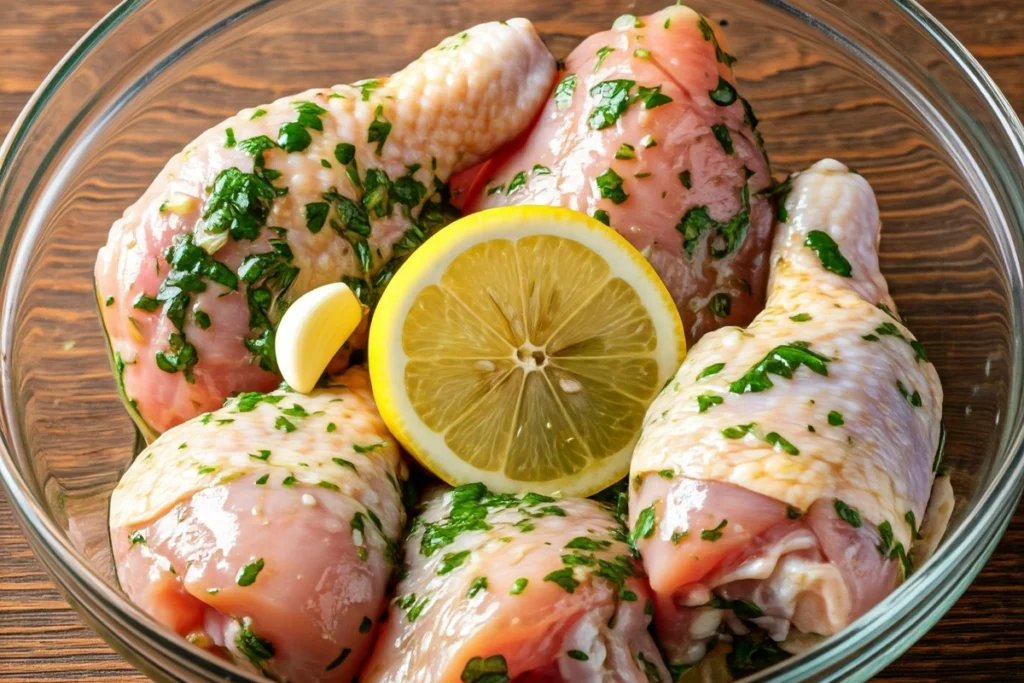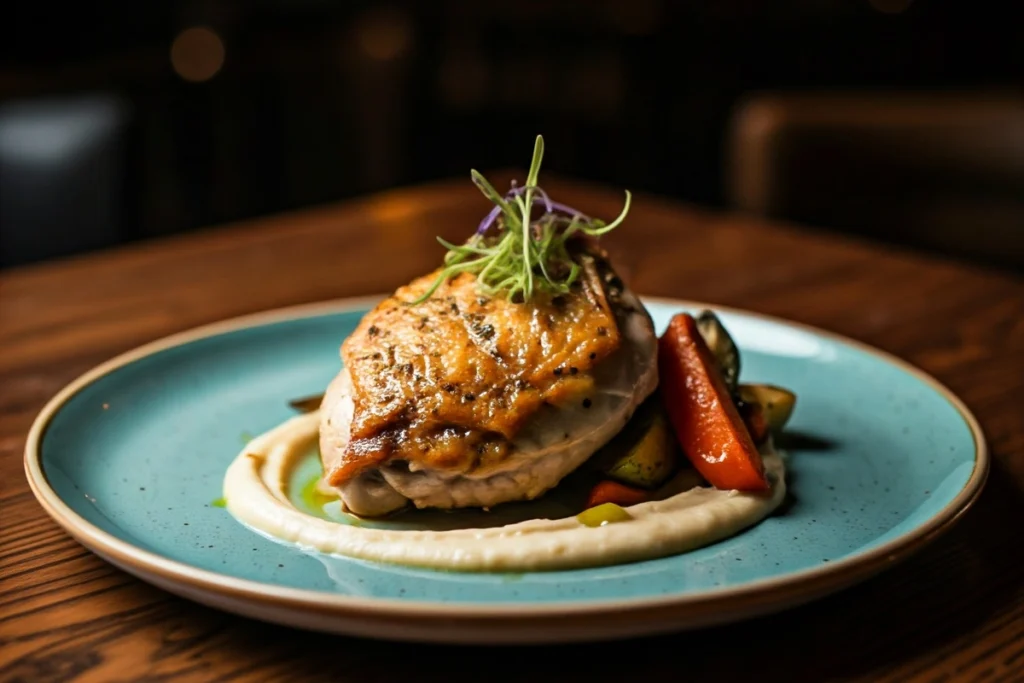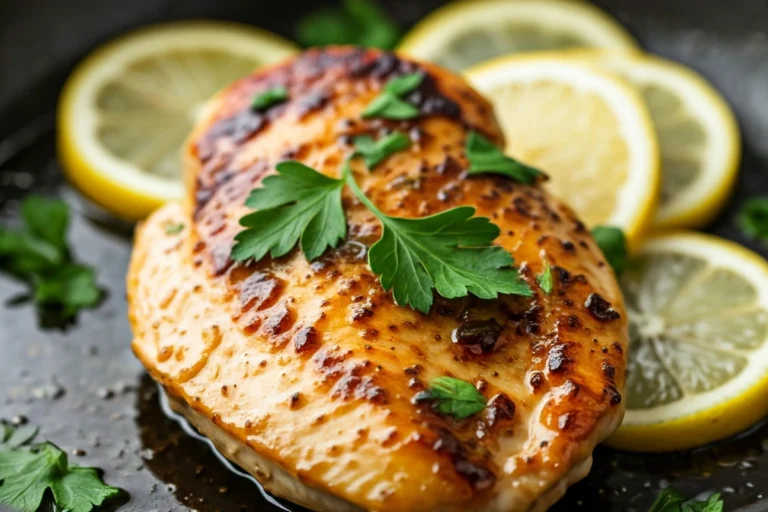Discover a quick and flavorful method for preparing how to make lemon garlic chicken. Enjoy tangy, savory perfection with minimal effort.
Preparation Essentials for how to make lemon garlic chicken
Learning how to make lemon garlic chicken starts with the right setup. Initially, gather fresh lemons, quality chicken cuts, and a generous portion of garlic. Indeed, the ingredients you choose will affect every bite. Comparatively, using fresh garlic yields more intense flavor than pre-minced options. Therefore, wash your chicken thoroughly, pat it dry, and check for any remaining bone fragments.
Equally important is the cooking surface. A sturdy cutting board keeps your workstation safe and organized. Meanwhile, keep a sharp knife on hand for efficient slicing. Altogether, selecting the right tools simplifies your meal preparation. Eventually, you will notice how these details enhance your dish.
Remember to keep everything clean and sanitized. Undoubtedly, proper hygiene reduces cross-contamination. Furthermore, ensure you have enough space to maneuver. Basically, the objective is to streamline the process. Consequently, you will save time and produce superior results.
Choosing Ingredients for how to make lemon garlic chicken
When deciding how to make lemon garlic chicken, picking fresh items is key. Chiefly, the chicken should feel firm and appear slightly pinkish, indicating optimal quality. Moreover, selecting vibrant yellow lemons with a smooth peel ensures maximum juice. Another factor is the garlic’s firmness. Because fresh garlic has tighter cloves and emits a bold aroma, you can expect a richer taste.
Additionally, consider using minimal added fat or oil. Nevertheless, a small drizzle of olive oil or a preferred neutral oil helps lock in moisture. Consequently, the chicken retains a satisfying texture. Comparatively, too much oil risks a greasy outcome. Thus, moderate amounts provide the ideal balance. Finally, incorporate seasonings like black pepper or dried herbs for extra complexity, especially if you desire a nuanced profile.
The Perfect Cookware for how to make lemon garlic chicken
Individuals exploring how to make lemon garlic chicken often wonder about the best cookware. Generally, nonstick pans offer ease of use, while cast iron skillets deliver excellent heat retention. However, stainless steel pans also perform admirably, particularly when searing. Conversely, avoid warped or uneven pans that hamper consistent browning.
Moreover, ensure the size of your pan matches the quantity of chicken. Too large a pan can lead to uneven heat distribution. Conversely, an overcrowded pan will cause steaming rather than browning. Hence, choose a pan that allows each piece of chicken ample space. This approach fosters crisp edges and caramelization.
In essence, high-quality cookware promotes uniform cooking. Undoubtedly, consistent heat ensures that the lemon and garlic flavors fuse well with the meat. Consequently, you avoid raw spots and burnt edges. Ultimately, choosing reliable cookware sets the foundation for a succulent, aromatic dish.
Step-by-Step Guide to how to make lemon garlic chicken
Now that you’ve prepared your tools, it’s time to dive into the cooking phase. Initially, preheat your oven or stovetop pan to medium-high heat. Because precise temperature ensures a proper sear, watch the pan closely. Equally, the right heat level prevents scorching your lemon-garlic marinade.
First, season your chicken with salt, pepper, and a dash of dried herbs. Undoubtedly, balanced seasoning promotes an appetizing crust. Then, place the chicken pieces in a small bowl. Subsequently, add minced garlic, lemon juice, and a modest drizzle of oil. Gently massage these ingredients into the chicken, coating every surface.
Next, rest the chicken for a few minutes. Consequently, the flavors meld better. Meanwhile, set your pan on the stove and let it reach the correct temperature. Finally, place each piece of chicken in the pan, ensuring they do not overlap. Cook for several minutes on each side until golden brown. Afterward, transfer the chicken to a preheated oven if needed, or finish cooking on the stovetop by reducing the heat.
Marinating Techniques for Zesty Results
Marinating plays a vital role in achieving tangy lemon flavors. Specifically, combining lemon juice, minced garlic, and subtle seasoning yields a citrusy layer that penetrates the chicken. Nevertheless, timing matters. Generally, marinating for 30 minutes infuses enough flavor without breaking down the meat’s structure. Conversely, an overly long marinade risks overly soft chicken.
Furthermore, consider adding grated lemon zest to the mixture. Undoubtedly, zest enhances brightness. Meanwhile, tossing in fresh parsley or basil offers an aromatic lift. Altogether, these extra touches ensure depth in every bite. Finally, keep your marinating mixture sealed in a container or resealable bag to lock in freshness.
Essentially, marinating streamlines your cooking process. Chiefly, pre-infused flavors lessen the need for heavy sauces. Consequently, you can maintain a lighter, healthier dish. Nevertheless, remember to refrigerate your marinating chicken. This step prevents unwanted bacterial growth. Hence, store the mixture in the cold until you’re ready to cook.

Ensuring Juiciness and Tenderness
Achieving tender, moist chicken requires deliberate steps. Firstly, avoid overcooking. Because chicken dries out quickly, carefully monitor internal temperature. Ideally, the chicken reaches an internal reading of 165°F. Another method is to slice a piece open. If juices run clear, the chicken is done.
Subsequently, let the chicken rest for a few minutes once it’s cooked. Undoubtedly, this resting period allows the juices to redistribute. Consequently, you won’t lose flavor when you slice into it. In addition, a short rest period keeps the meat moist. Overall, this simple practice elevates the final dish.
Finally, slice the chicken against the grain. Comparatively, this technique helps avoid chewy bites. Indeed, each slice remains tender. Meanwhile, a garnish of fresh herbs or an extra drizzle of lemon juice can further enliven the plate. Altogether, these measures guarantee that every mouthful bursts with citrus and garlic.
Essential Tips for how to make lemon garlic chicken
Cooking novices often seek additional guidance on how to make lemon garlic chicken effectively. Therefore, pay attention to key tips. First, never skip tasting the marinade before use. Because seasoning preferences differ, you may adjust salt or acidity to taste. Thus, you can craft a personalized balance.
Moreover, use a meat thermometer for accuracy. Specifically, it prevents guesswork and ensures thorough cooking. Consequently, you minimize the risk of dry or undercooked meat. Meanwhile, if you find the flavors too mild, add more garlic or lemon zest. Conversely, dilute overly strong marinade with water or chicken broth.
Equally crucial is maintaining proper heat levels. Undoubtedly, scorching garlic can impart a bitter aftertaste. Therefore, watch the pan’s heat and reduce it if garlic starts to brown too quickly. In essence, cooking with gentle care leads to the best outcomes. Another tip is to use fresh lemons whenever possible. Bottled juice may lack the intensity of natural citrus.
Customizing Side Dishes for a Balanced Plate
Pairing your chicken with complementary sides contributes to a complete meal. Commonly, steamed vegetables add vibrant color. Likewise, a light salad with crisp lettuce and tomatoes accentuates the chicken’s zest. Meanwhile, roasted potatoes deliver a heartier option. Consequently, these choices bring variety to the table.
Additionally, consider a simple cucumber-yogurt sauce for a refreshing contrast. Basically, tangy yogurt, fresh herbs, and diced cucumber create a cooling side. Furthermore, grains like quinoa or brown rice absorb leftover chicken juices. Indeed, they complete a satisfying meal. In short, exploring different side dishes broadens your culinary horizon.
Altogether, pairing your zesty chicken with harmonious sides multiplies the enjoyment. Particularly, fresh produce and whole grains elevate nutritional value. Undoubtedly, your family and friends will savor a well-rounded dinner. Ultimately, variety in sides ensures each plate is colorful, nutritious, and fulfilling.
Adapting for Special Diets
Many individuals on restrictive diets still wonder about enjoying these flavors. Happily, how to make lemon garlic chicken can be adapted for low-sodium or gluten-free needs. Chiefly, replace traditional salt with a salt-free seasoning blend. Consequently, your dish remains tasty and health-conscious. Furthermore, check labels on dried herbs to confirm they contain no hidden gluten.
Subsequently, opt for gluten-free flour if you wish to coat your chicken lightly before cooking. Comparatively, a mix of cornstarch and seasonings also produces a lovely crust. Meanwhile, if you require low-fat guidelines, reduce the amount of oil or use a cooking spray. Explicitly, these changes do not undermine the lemony goodness.
Overall, customizing this recipe encourages more people to enjoy it. Indeed, simple tweaks can yield an inclusive meal. Therefore, no one needs to feel excluded at your dinner table. Equally, you maintain a universal approach without sacrificing flavor. Ultimately, tailoring recipes helps everyone feel comfortable and satisfied.
Sauces and Marinades for how to make lemon garlic chicken
The sauce you choose can dramatically transform how to make lemon garlic chicken. Certainly, a classic lemon-butter sauce creates a velvety finish. Nevertheless, substituting butter with a lighter spread or margarine can reduce saturated fat. Accordingly, stir in freshly chopped parsley for a burst of color.
Alternatively, incorporate chicken broth to form a gravy-like consistency. Basically, whisk a teaspoon of cornstarch into cold water, then blend it with broth. Eventually, you’ll get a smooth sauce that pairs with the lemon and garlic. Another strategy is to add a touch of honey for a hint of sweetness. Conversely, if you prefer tangier options, add more lemon juice.
Certainly, the type of marinade also influences the final taste. Indeed, marinating the chicken in herbs, spices, and fresh citrus intensifies its flavor. Furthermore, store leftover marinade in a separate container and discard any marinade that touched raw meat. Hence, you maintain food safety standards. Altogether, the combination of sauce and marinade will define each savory mouthful.
Cooking Methods for Different Preferences
Some people prefer oven-baked chicken, while others enjoy grilling. Specifically, you can adapt how to make lemon garlic chicken to a variety of techniques. If baking, preheat your oven to around 400°F. Place chicken on a baking sheet lined with parchment paper or foil. Additionally, baste the chicken with a bit of leftover marinade halfway through. Consequently, it stays moist.
Conversely, grilling imparts a smoky essence. In that case, preheat your grill to medium-high heat and brush the grates lightly with oil. Place the chicken, skin side down if applicable, and flip once you see clear grill marks. Generally, grilling times vary based on thickness. Thus, keep an eye on the internal temperature to ensure doneness.
Lastly, you could sauté or stir-fry the chicken in a wok. Particularly, this method suits anyone seeking a fast meal. Just add small chicken pieces to a hot pan with oil and aromatics. Equally, drizzle more lemon juice near the end for extra zest. Eventually, your kitchen will fill with a delightful aroma, signaling that dinner is ready.
Serving Suggestions for how to make lemon garlic chicken
Presentation plays a significant role in elevating your meal. Undoubtedly, a simple garnish can enhance the visual appeal. Therefore, sprinkle chopped parsley or basil atop your cooked chicken. Meanwhile, serve it on a bed of colorful vegetables to showcase contrasting hues.
Moreover, plating it with sliced lemon wedges helps guests adjust acidity according to their preference. Indeed, this approach allows everyone to customize their dish. Additionally, a decorative drizzle of sauce across the plate looks elegant. Particularly, a swirl of lemon-garlic reduction can catch the eye.
Finally, pair your chicken with a crisp white plate to highlight its golden-brown color. Undoubtedly, these small steps leave a lasting impression. Altogether, thoughtful plating creates a dining experience rather than a mere meal. Hence, your guests will appreciate the attention to detail. Ultimately, they’ll remember both the taste and the presentation.

Finalizing the Meal and Storage Tips
Concluding your journey of how to make lemon garlic chicken, it’s helpful to prepare storage strategies for leftovers. Because this dish often yields more servings, proper storage avoids waste. Primarily, place any extra chicken in an airtight container. Then, refrigerate or freeze promptly. Consequently, you retain quality and flavor.
When reheating, opt for a moderate temperature to prevent dryness. Particularly, use the microwave or oven at a low setting. Cover the container with a lid or wrap to preserve moisture. If the chicken appears dry, add a dash of broth or lemon juice to revitalize the flavor. Unquestionably, you can still enjoy delicious leftovers.
Equally, be mindful of time constraints. Generally, cooked chicken remains fresh in the fridge for up to four days. Conversely, freezing extends its life significantly, usually up to three months. Ultimately, label your containers with dates. Thus, you stay organized and ensure safe consumption later.
Nutritional Information (Per 100g)
| Nutrient | Approximate Value |
|---|---|
| Calories | 165 kcal |
| Protein | 31 g |
| Fat | 3.5 g |
| Carbohydrates | 1 g |
| Fiber | 0 g |
| Sodium | 75 mg |
| Vitamin C | 6 mg |
| Iron | 0.7 mg |
(Values are estimates and may vary based on exact ingredients.)
FAQ (People Also Ask)
Below are frequently asked questions about lemon garlic chicken. This section addresses common concerns and provides concise yet informative answers.
1. Can I use chicken thighs instead of chicken breasts?
Absolutely. Chicken thighs offer a richer taste and remain juicy. However, they do contain slightly more fat. Adjust cooking time accordingly, ensuring the internal temperature reaches 165°F.
2. Is it necessary to marinate the chicken overnight?
Not necessarily. Marinating for about 30 minutes infuses adequate flavor. If you choose an overnight marinade, reduce the acidity to prevent an overly soft texture.
3. How can I make the dish spicier?
Add chili flakes or a dash of hot sauce to the marinade. Consequently, the heat level increases. You can also sprinkle red pepper flakes right before serving for an extra kick.
4. Can I prepare this recipe without oil?
Yes. Consider using cooking spray or a nonstick skillet. This method helps cut down on added fats while still locking in moisture. You can also rely on the natural fat from the chicken.
5. What’s the best way to store leftovers?
Refrigerate them in an airtight container for up to four days or freeze for longer. When reheating, add a splash of chicken broth or lemon juice to keep the meat moist and flavorful.
6. Do I need fresh lemons, or can I use bottled lemon juice?
Fresh lemons typically yield brighter citrus notes. However, bottled juice is a convenient substitute if fresh fruit is unavailable. Just ensure it’s pure lemon juice without added preservatives.
7. How do I stop the garlic from burning?
Monitor your pan’s heat and stir frequently. If the garlic starts browning too quickly, lower the temperature. You can also add garlic midway through cooking to prevent scorching.
8. Can I add other herbs for extra flavor?
Certainly. Basil, thyme, or oregano all blend well with lemon and garlic. Experiment with combinations until you find your favorite profile. You can also sprinkle fresh herbs after cooking for a vibrant finish.

